Seasoned Tomato Sauce Recipe for Home Canning
This post may contain affiliate links, which means that I may receive a commission if you make a purchase using these links. As an Amazon Associate I earn from qualifying purchases.
No store-bought sauce compares to homemade. This seasoned tomato sauce for canning is rich with fresh tomato flavor, herbs, and garlic. Preserve the taste of summer in every jar.
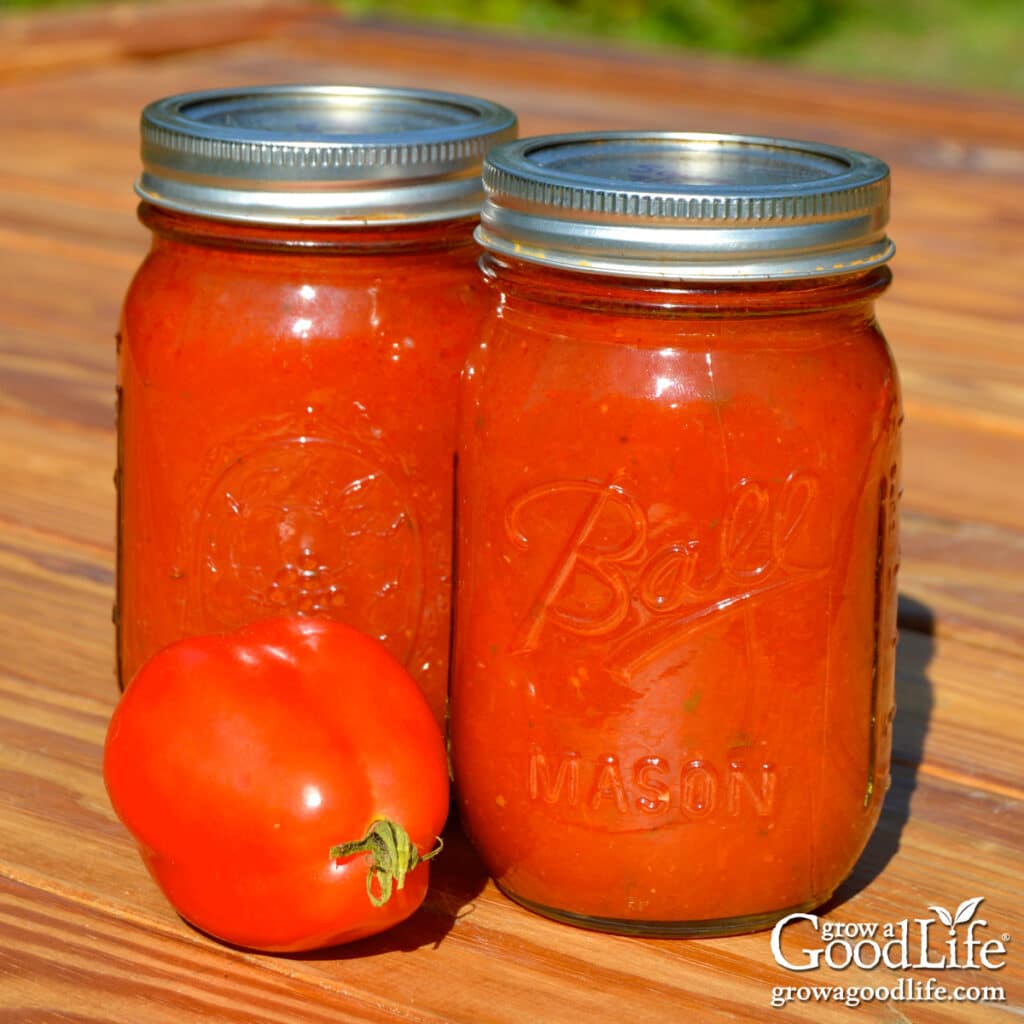
There was always a pot of tomato sauce simmering in our kitchen when I was growing up. In my Italian family, homemade sauce wasn’t a recipe; it was a way of life. We never bought jars from the store because we canned our own fresh tomatoes every summer. When I started growing my own garden years later, preserving a year’s worth of tomato sauce became one of my favorite seasonal traditions too.
This seasoned tomato sauce recipe for canning is the one I return to year after year. It’s adapted from the Ball Blue Book Guide to Preserving and is the closest I’ve found to my family’s tomato sauce. It uses fresh tomatoes, onions, garlic, and herbs, and includes just a little extra virgin olive oil for a classic Italian flavor. Simple. Authentic. Reliable.
The sauce is rich and full-bodied, but still versatile enough for everyday meals. Toss it with pasta, layer it into lasagna, simmer it with meatballs, or bake it with chicken Parmesan. If you are looking for a dependable tomato sauce recipe for canning that tastes like home and follows safe canning guidelines, this one belongs in your pantry.
Why You’ll Love This Recipe
- Classic homemade flavor: Made with ripe tomatoes, onions, garlic, herbs, and a touch of olive oil, this sauce has that rich, comforting taste you expect from authentic Italian cooking.
- Garden to jar: A perfect way to preserve your summer tomato harvest and enjoy fresh flavor all year long.
- Safe and reliable: Adapted from a tested Ball Blue Book recipe, this method follows safe home canning guidelines for dependable results.
- Versatile for meals: Use this all-purpose sauce for pasta, pizza, casseroles, soups, or any recipe that calls for tomato sauce.
About the Ingredients
Tomatoes
Paste, or plum-type tomatoes like Roma, San Marzano, Amish Paste, and Juliet are ideal for canning sauce because they are meaty and contain fewer seeds and less juice than slicing tomatoes, resulting in a thicker sauce. This recipe uses about 22.5 pounds of paste tomatoes to create a rich, flavorful sauce that thickens nicely.
Choose firm, ripe tomatoes from healthy plants for the best results. Avoid overripe, bruised, or damaged tomatoes, as these can affect both flavor and safety. Do not use tomatoes from diseased or frost-killed vines, as their acidity may have changed, and they can harbor harmful pathogens that are not destroyed during water bath canning.
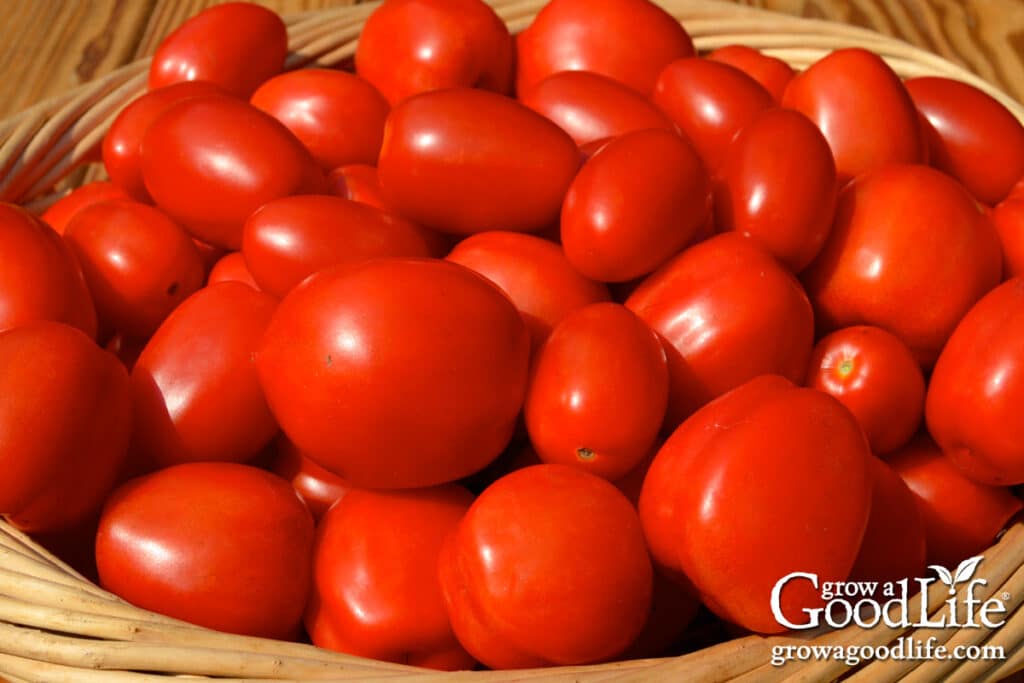
Onions
Onions add depth of flavor and help build the sauce base. You’ll need 3 cups of chopped onions, which is about 3 medium to large onions.
Garlic
Garlic adds wonderful aroma and flavor to this sauce. You will need 6 cloves of garlic, minced. As with onions, do not increase the amount to maintain safe acidity and density when canning.
Extra Virgin Olive Oil
This recipe calls for 1/4 cup of extra virgin olive oil to sauté the onions and garlic. While oil is generally discouraged in canning recipes, this one is safe as written because it comes from a tested recipe from Ball. You may reduce or omit the olive oil if you prefer, but do not increase it.
Dried Herbs and Seasoning
Dried oregano, bay leaves, ground black pepper, salt, and optional red pepper flakes give this sauce a classic Italian flavor.
Sugar and salt are for flavor and do not affect canning safety. Feel free to omit or adjust to taste.
Lemon Juice or Citric Acid (Required for Safety)
When canning tomatoes, added acid is required to ensure the sauce reaches a safe pH level that prevents the growth of Clostridium botulinum bacteria, which causes botulism. Even though tomatoes are naturally acidic, today’s tomato varieties vary in acidity, so acidifying each jar is essential for safe water bath canning.
You can use either citric acid or bottled lemon juice:
- Citric acid: My preferred option is citric acid because it doesn’t affect the flavor.
- Bottled lemon juice: A safe alternative that has a consistent and verified acid level. Don’t use fresh squeezed lemon juice because there is no way to know the level of acid in the juice.
Add the citric acid or bottled lemon juice directly to each jar before filling, using the amount specified in the recipe.
Tips for Canning Tomato Sauce
These quick tips will help you get the best flavor and texture while staying within safe home canning guidelines.
Remove Skins and Seeds After Simmering
Removing the skins and seeds is important for both safety and texture. The peels may harbor bacteria and add unwanted texture to the sauce. Additionally, the peels and seeds may affect the density of the sauce, preventing heat from penetrating properly when processed in a water bath canner.
However, this recipe uses a slightly different method than most tomato sauce recipes. Instead of peeling the tomatoes first, this recipe simmers the tomatoes with the skins and seeds, and then strains them out afterward before canning.
Cooking the tomatoes this way helps extract natural pectin from the skins, which gives the sauce a thicker and richer consistency.
Here’s how it works:
- First, the tomatoes are cooked down with skins and seeds still intact.
- Once the sauce has reduced by half, it is strained through a food mill or tomato strainer to remove skins and seeds.
- The smooth sauce is then returned to the pot, reheated, and canned.
This method delivers a full-bodied, homemade tomato sauce with great texture while staying within tested canning safety guidelines.
Note: If you don’t have a food strainer or food mill, you can peel and seed the tomatoes before cooking using the blanch-and-peel method instead. See: How to Peel Tomatoes.
Safe Ingredient Swaps
You can make a few minor changes to this tomato sauce recipe without compromising canning safety. Here are some adjustments you can make:
- Tomatoes: Any tomato variety will work, and you can mix types, but juicy tomatoes (such as heirlooms or slicers) may require extra simmering time to thicken.
- Dried herbs and spices: You may substitute other dried herbs for the oregano, such as basil, thyme, rosemary, or Italian seasoning mixes, in equal amounts. You can also omit the bay leaves and red pepper flakes, as they are used solely for flavor.
- Add fresh basil: It’s safe to add a small sprig of fresh basil or a fresh basil leaf to each jar. Use only unblemished leaves that have been thoroughly rinsed. This small amount won’t affect acidity and adds a burst of garden-fresh flavor.
- Swap onion variety: Yellow onions are traditional, but white, red, or sweet onions also work. You may reduce the amount, but do not increase. Onions are a low-acid ingredient and must stay within tested ratios for safety.
- Reduce the garlic: You may use less garlic, but do not increase it. If you’d like a stronger garlic flavor, you can add garlic powder, which is safe for canning.
For more ideas on safe substitutions, see: How to Safely Modify Tomato Canning Recipes.
No Water Bath Canner? No Problem.
You don’t need a specialty canning pot to make home-canned tomato sauce. You can use a large deep stockpot as long as:
- You use a canning rack or a round cake rack on the bottom so jars don’t sit directly on the heat.
- It is tall enough to cover your jars with at least 2 inches of water, and at least two more inches of air space to prevent boiling water from splashing out.
- The pot has a tight-fitting lid to maintain a steady boil.
This alternative works just as well. You can process the jars in smaller batches depending on how many jars your pot will hold.
How to Make and Can Seasoned Tomato Sauce
This recipe is adapted from Seasoned Tomato Sauce in the Ball Blue Book Guide to Preserving and follows safe, tested home canning guidelines. My version makes a smaller batch that is easier to manage and fits comfortably in standard saucepots.
I’ve also made a few minor flavor adjustments while staying within safe canning rules:
- Slow-simmered over low heat to develop deep, classic tomato flavor.
- Slightly less salt and a little more sugar to balance acidity.
Only the batch size, cooking method, and seasoning have been adjusted. The ingredient ratios and processing times remain the same as the trusted Ball version.
If you’re new to water bath canning, you may want to review the basics before you begin: Water Bath Canning for Beginners.
To stay organized during your canning session, I also recommend using my free Home Canning Checklist. It includes a step-by-step guide of the entire canning process and space to record each batch you preserve. Get the checklist here:
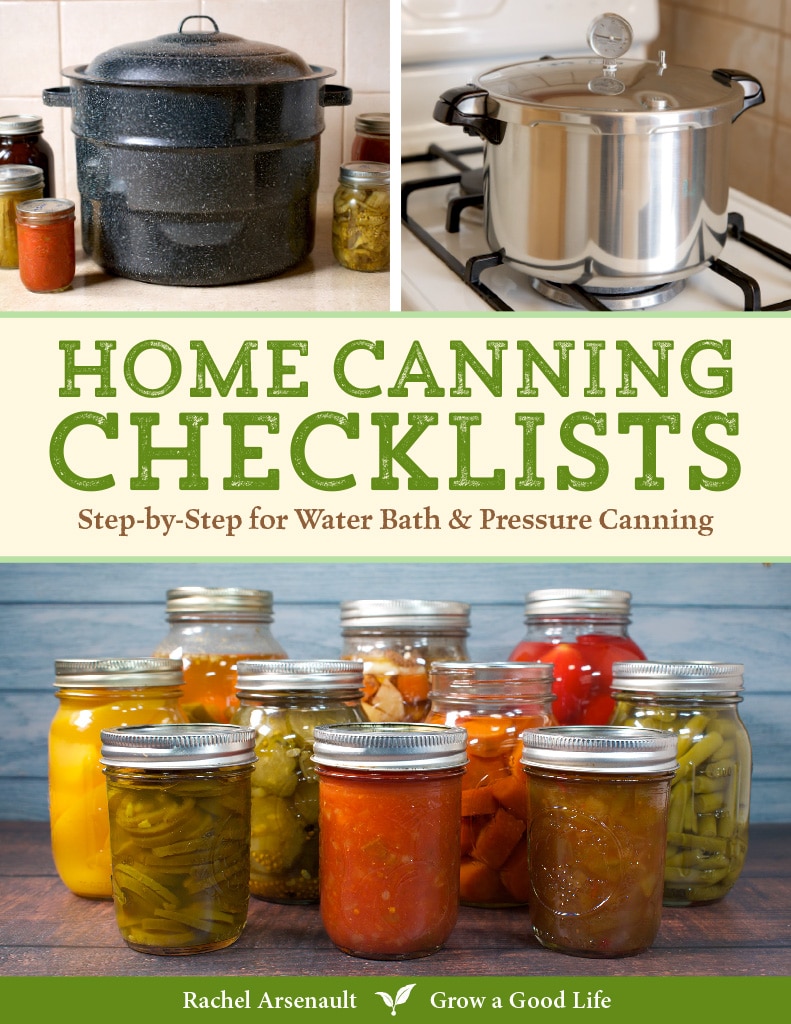
Grab your Free copy
Home Canning Checklists
You’ll find the full printable recipe at the bottom of this article, but the step-by-step instructions below will walk you through the process with helpful tips for success.
Step 1: Gather Your Kitchen and Canning Equipment
Before you begin, gather all of your kitchen and canning tools and equipment. Having everything ready will make the canning process smoother and more efficient.
You will need:
- Water bath canner with canning rack
- Canning Jars: 16 half-pint canning jars, or 8 pint sized canning jars, or 4 quart sized jars
- Canning lids and bands (new lids for each jar, bands can be reused)
- Canning tools: jar lifter, canning ladle, funnel, and bubble popper
- Large canning ladle
- Kitchen scale
- Food strainer, food mill, or fine mesh sieve
- Large stainless steel saucepan or stockpot
- Large prep bowls
- Skillet
- Measuring cups and spoons
- Sharp knife and cutting board
- Clean kitchen towels
Step 2: Prepare the Ingredients
- Prepare the Tomatoes: Weigh 22.5 pounds of tomatoes. Rinse well under cool running water to remove dirt and debris, and set aside on clean kitchen towels to air dry.
- Prepare the Onions: Peel the onions, then chop and measure 3 cups of chopped onions.
- Prepare the Garlic: Peel and mince 6 cloves of garlic.
Step 3: Make the Tomato Sauce
Heat a large skillet over medium heat and add the olive oil. Sauté the chopped onions until softened, about 5 minutes. Add the minced garlic and cook briefly until fragrant, about 30 seconds. Transfer the onion and garlic mixture to a large saucepot.
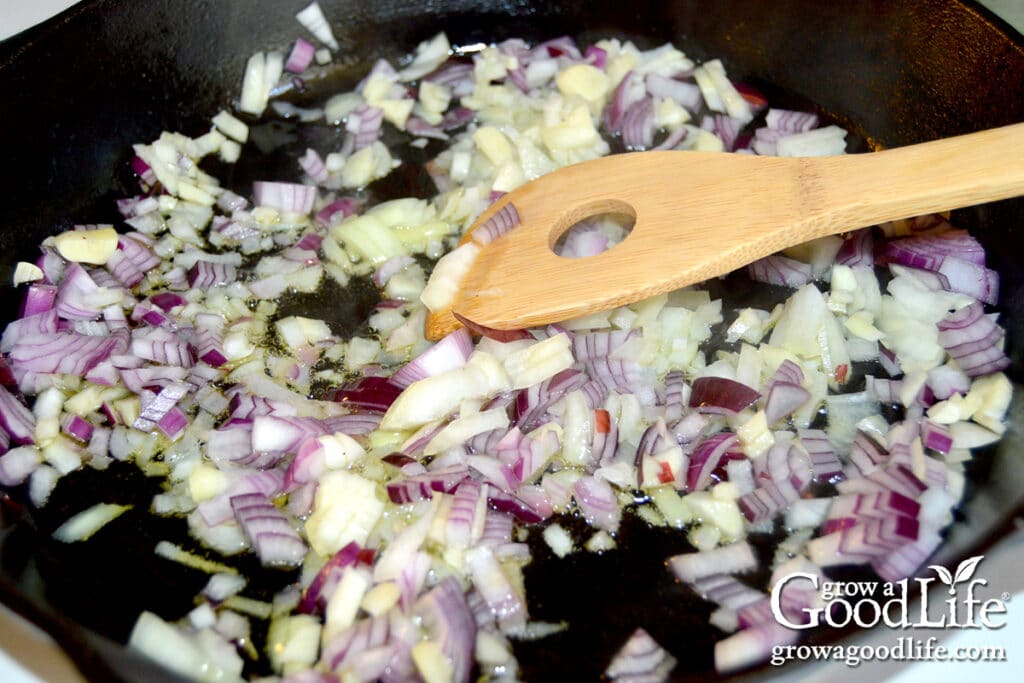
Cut the tomatoes into quarters. Add the quartered tomatoes to the pot along with the dried oregano, bay leaves, black pepper, sugar, and red pepper flakes (if using). Hold off on adding the salt until later so you can season to taste after the sauce has cooked down.

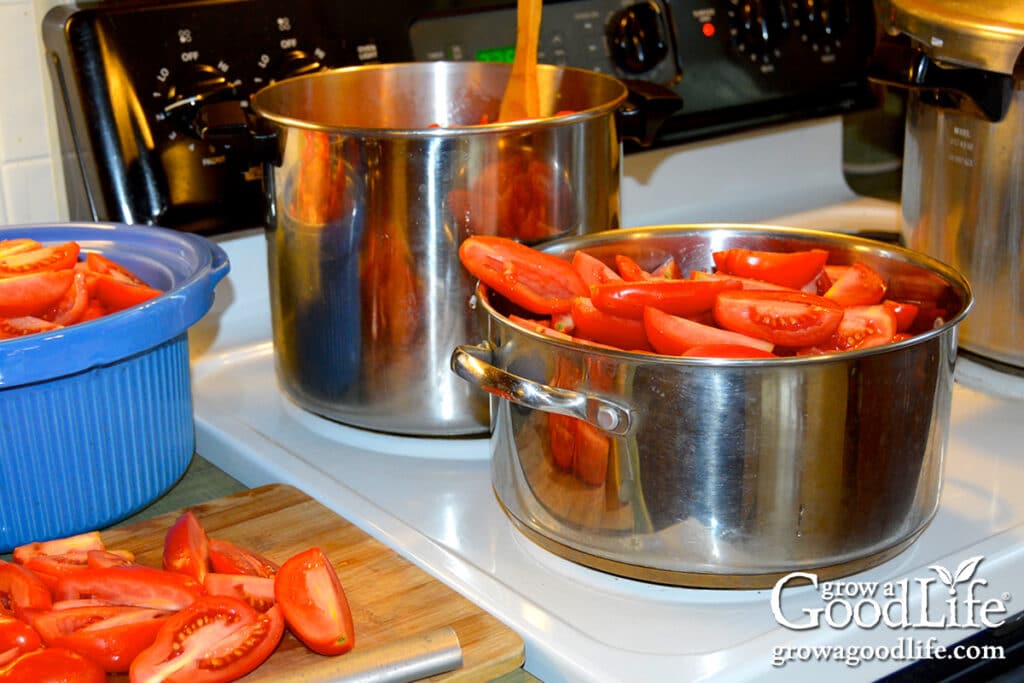
Bring the mixture to a boil over medium-high heat, stirring often to prevent sticking. Press the tomatoes with a spoon or potato masher to release their juices. Once the tomatoes soften and begin to break down, reduce the heat to low and simmer uncovered to allow excess moisture to evaporate.

Continue simmering until the sauce reduces by about half its original volume. Cooking time will vary depending on how juicy your tomatoes are, plan on 3 to 4 hours. Stir occasionally to prevent sticking and scorching.
If you are using more than one pot to fit all the tomatoes, divide the ingredients evenly and combine the sauce into one pot as it reduces.
Once the volume is reduced by half, turn off the heat, and let it cool slightly so you won’t burn yourself when straining.
Step 4: Prepare the Canner and Jars
While the sauce cools, prepare the jars, set up the canner, and organize your work area.
Wash your jars, lids, bands, and canning tools in warm, soapy water. Rinse well, and set the lids, bands, and tools aside to air dry until you are ready to use them.
Place the jar rack in the water bath canner, set the jars upright in the canner, and add water to cover the jars. Bring the canner to a simmer (180˚F) for 10 minutes, and keep the jars hot until you are ready to fill them.
Organize your workspace by laying a clean towel on the counter and placing your funnel, ladle, bubble popper, and damp cloth within reach. Also, set out your citric acid or bottled lemon juice, along with a measuring spoon, so it’s ready when you fill the jars.
Step 5: Strain the Sauce
Once the sauce has cooled slightly, it’s time to remove the skins and seeds.
Remove the bay leaves, then run the sauce through a food strainer or food mill to separate the solids from the tomato pulp. Work in batches and collect the smooth sauce in a clean container.
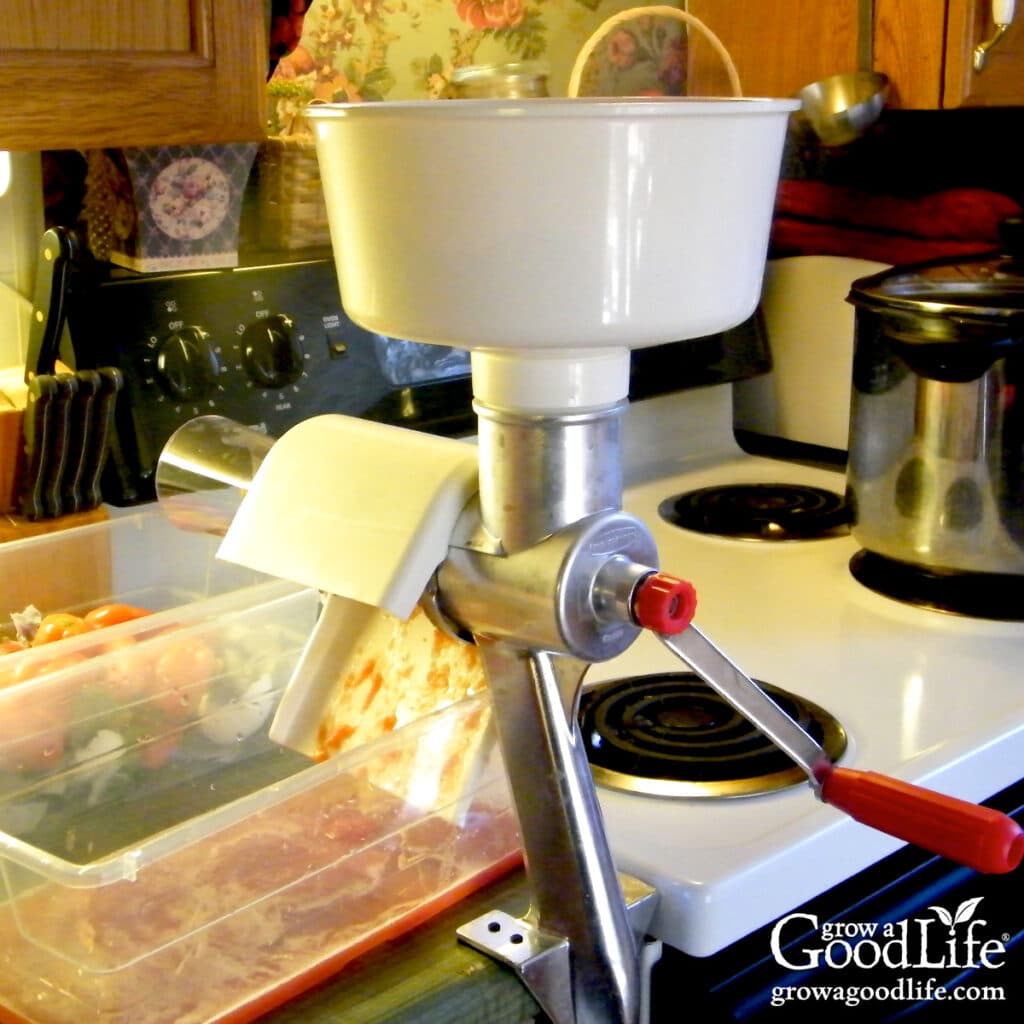
Return the strained sauce to the stove and bring it back to a steady simmer (about 180°F) over low heat. Taste and add salt to your preference, stirring well. Keep the sauce hot as you move on to filling the jars.
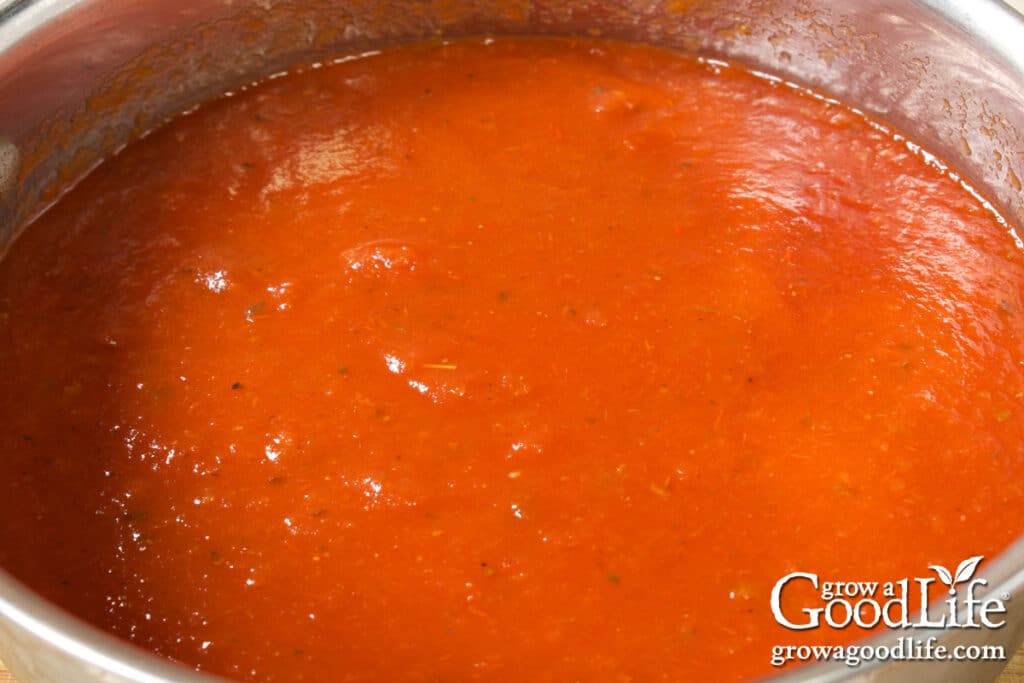
Note: If your sauce still seems thin after straining, simmer it uncovered until it reaches your desired thick sauce consistency. Stir frequently to prevent scorching as the mixture thickens.
Avoid adding tomato paste, flour, cornstarch, or other thickeners. These can alter the sauce’s density and make it unsafe for canning. Instead, allow the sauce to thicken naturally through gentle simmering.
Step 6: Fill the Jars with Tomato Sauce
Use the jar lifter to remove one hot jar from the canner. Carefully drain the water back into the canner and place the jar on the towel-lined workspace. Keep the remaining jars in the canner so they stay hot.
Measure and add citric acid or lemon juice to the jar in the quantity specified below:
- Half-pint jar: Add 1/8 teaspoon citric acid or 1/2 tablespoon bottled lemon juice
- Pint jar: Add 1/4 teaspoon citric acid or 1 tablespoon bottled lemon juice
- Quart jar: Add 1/2 teaspoon citric acid or 2 tablespoons bottled lemon juice
Place the canning funnel over the jar and ladle in the hot tomato sauce, leaving 1/2 inch of headspace at the top.
Run the bubble popper through the jar to release trapped air bubbles. Adjust headspace if needed by adding more sauce.
Wipe the rim with a clean, damp cloth to remove any residue. Center a lid on the jar, add the band, and tighten it until fingertip tight. Return the filled jar to the canner and repeat with the remaining jars.
Step 7: Process the Jars in a Boiling Water Bath Canner
Once all jars are filled and returned to the canner, adjust the water level so it covers the tops of the jars by at least 2 inches. Add more hot water if needed.
Cover the canner and bring it to a rolling boil over high heat. Once the water is boiling vigorously, start your timer and process the jars for the time listed in the recipe card below, adjusting for altitude if necessary.
Step 8: Cool and Store
When the processing time is complete, turn off the heat and remove the canner lid. Let the jars sit in the hot water for 5 minutes to help them adjust gradually to the temperature change.
Spread a dry towel on the counter. Use a jar lifter to remove each jar carefully from the canner, keeping the jars upright. Place them on the towel, leaving space between each jar to allow air circulation as they cool. Do not tighten the bands or check the seals at this point.
Let the jars cool undisturbed for 12 to 24 hours. After cooling, test the seals by pressing the center of each lid:
- If the lid is firm and does not flex up and down, it is sealed.
- If a lid pops or moves, the jar did not seal properly. Refrigerate and use within a few days, or transfer to a freezer container and freeze for up to 6 months.
Remove the screw bands, wash the jars in soapy water to remove any residue, rinse well, dry, and label them with the date and contents. Store sealed jars in a cool, dark place. For best quality, use within 12 to 18 months. Refrigerate after opening and use within 3 to 5 days.
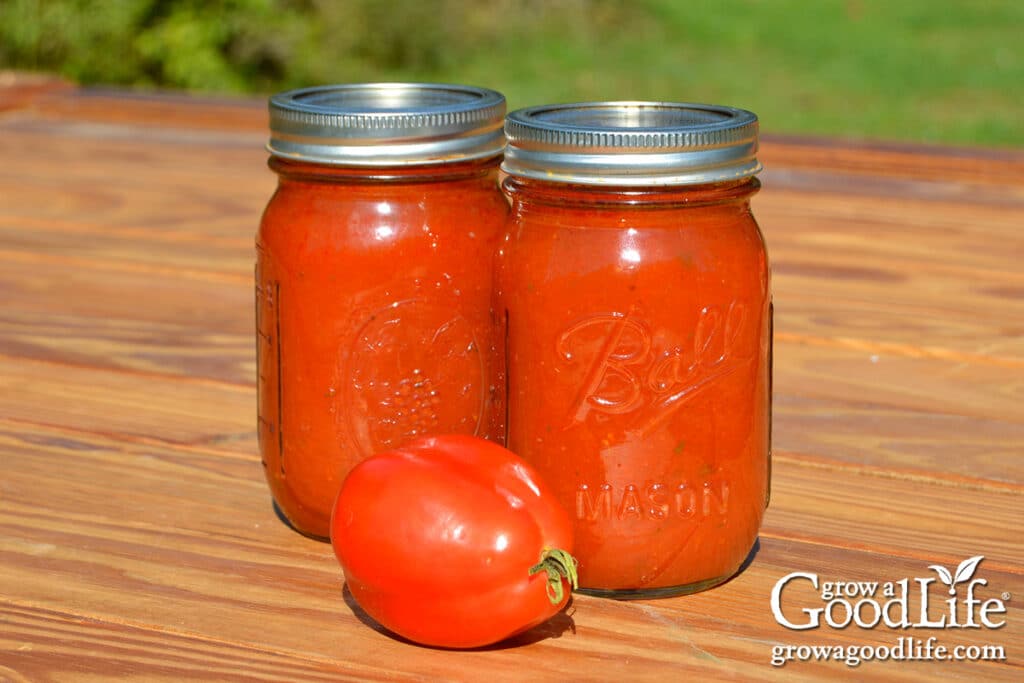
Ways to Use Seasoned Tomato Sauce
This classic Italian-style tomato sauce is a versatile pantry staple you’ll reach for again and again. Here are some delicious ways to enjoy it:
- Toss with pasta: Perfect with spaghetti, penne, baked ziti, or Homemade Ricotta Gnocchi for a comforting dinner.
- Layer in pasta bakes: Great for stuffed shells, baked ravioli, or manicotti. Try it in Zucchini Lasagna for a hearty garden-to-table meal.
- Use in skillet meals: Try it in American Chop Suey, a New England style family favorite.
- Serve as a dipping sauce: Warm it up for breadsticks, mozzarella sticks, or Zucchini Garlic Bites.
- Make quick pizzas: Spread it over pizza dough, add cheese and toppings, and bake.
Once you have jars of this sauce on your pantry shelf, you’re never far from a homemade meal, even on the busiest nights.
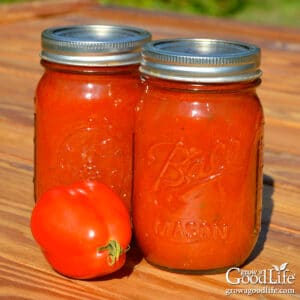
Seasoned Tomato Sauce Recipe for Canning
Ingredients
- 22.5 pounds paste tomatoes such as Roma, San Marzano, Amish Paste
- 3 cups chopped onions about 3 large onions
- 6 cloves garlic minced
- 1/4 cup extra virgin olive oil
- 3 dried bay leaves
- 1 tablespoon dried oregano
- 1 teaspoons sugar
- 1 1/2 teaspoons ground black pepper
- 1 teaspoon kosher salt or more to taste
- 1 teaspoon red pepper flakes optional
- citric acid or bottled lemon juice
Instructions
Prepare the Ingredients
- Weigh the tomatoes, rinse them well under clean, running water, and air-dry on clean towels.
- Remove the peelings from the onions. Chop and measure 3 cups of chopped onions.
- Peel the garlic and mince it.
Make the Tomato Sauce
- Heat a large skillet over medium heat, add the olive oil, and sauté the onions until softened.
- Add the garlic and cook briefly until fragrant, then add the mixture to your saucepan.
- Cut the tomatoes into quarters and add them to the saucepan.
- Add the bay leaves, oregano, sugar, black pepper, and red pepper flakes.
- Bring the pot to a boil over medium-high heat. Once the tomatoes begin to soften and release their juices, reduce the heat to low and simmer uncovered. Stir occasionally to prevent sticking.
- Continue simmering until the sauce reduces by about half its original volume. Cooking time will vary depending on how juicy your tomatoes are, plan on 3 to 4 hours. Stir occasionally to prevent sticking and scorching.
- Once the volume is reduced by half, turn off the heat, and let the sauce cool slightly before straining.
Prepare the Canner and Jars
- Wash your jars, lids, screw bands, and canning tools in hot, soapy water. Rinse thoroughly to remove all suds. Set aside to air dry on a clean kitchen towel.
- Place the jar rack in the water bath canner, then add the jars upright in the canner and cover them with water. Bring the canner to a simmer (180˚F) for 10 minutes, and keep the jars hot until you are ready to fill them.
Strain the Sauce
- Once the sauce has cooled slightly, remove the bay leaves, then run the sauce through a food strainer or food mill to separate the seeds and skins from the tomato pulp. Work in batches and collect the smooth sauce in a clean pot.
- Use a clean spoon and taste the sauce. Add salt and stir in. Taste again. Add more salt if needed.
- Return the sauce to the stove and bring it back to a steady simmer (about 180°F) over low heat. Keep the sauce hot as you fill the jars.
Fill the Jars with Sauce
- Spread a dry kitchen towel on the counter. Place the canning tools, lids, bands, citric acid or lemon juice, along with the measuring spoons, next to the towel.
- Use your jar lifter to remove a jar from the canner, drain it, and place it on the towel. Keep the remaining jars in the canner to keep them hot.
- Measure and add citric acid or lemon juice to the jar: • Half-pint jar: Add 1/8 teaspoon citric acid or 1/2 tablespoon bottled lemon juice• Pint jar: Add 1/4 teaspoon citric acid or 1 tablespoon bottled lemon juice• Quart jar: Add 1/2 teaspoon citric acid or 2 tablespoons bottled lemon juice
- Use your canning ladle and funnel to add the hot sauce to the warm jar, leaving 1/2-inch headspace.
- Swirl your bubble popper through the jars to release air bubbles.
- Wipe the rim of each jar with a damp towel. Center a lid on the jar, and screw on the band until it is fingertip tight.
- Use the jar lifter to place the jar back into the canner, and repeat with the remaining jars.
Process in a Boiling Water Bath Canner
- Once all the jars are in the canner, adjust the water level to 2 inches above the tops of the jars.
- Cover the canner and bring to a boil over high heat.
- Once the water boils vigorously, set your timer and process half-pints and pints for 35 minutes and quarts for 40 minutes at altitudes of less than 1,000 feet. Adjust the processing time for your altitude if necessary (see notes).
Cool and Store
- When the processing time is complete, turn off the heat, remove the cover, and let jars rest in the canner for 5 minutes.
- Spread a kitchen towel on the counter, and remove the cover by tilting the lid away from you so that steam does not burn your face.
- Use the jar lifter to carefully lift jars from the canner and place them on the towel. Keep the jars upright, and don't tighten bands or check the seals yet.
- Let the jars sit undisturbed for 12 to 24 hours to cool and seal.
- After the jars have cooled for at least 12 hours, check to be sure the lids have sealed by pushing on the center of the lid. The lid should not pop up. If the lid flexes up and down, it did not seal. Refrigerate the jar and use it within a few days.
- Remove the screw on bands and wash the jars to remove residue. Label, date, and store your jars in a cool, dark place. Use within 12 to 18 months for the best flavor. Refrigerate the sauce once opened and consume within a few days.
- Yield: About 16 half-pints, or 8 pint jars, or 4 quart jars, depending on how much the sauce reduces.
Notes
- 1,001–3,000 feet: 40 minutes
- 3,001–6,000 feet: 45 minutes
- 6,001–8,000 feet: 50 minutes
- 8,001–10,000 feet: 55 minutes
- 1,001–3,000 feet: 45 minutes
- 3,001–6,000 feet: 50 minutes
- 6,001–8,000 feet: 55 minutes
- 8,001–10,000 feet: 60 minutes
Nutrition
Canning your own seasoned tomato sauce is one of the most rewarding ways to preserve the harvest. This rich, flavorful sauce captures the taste of the summer garden in every jar, ready to be used for quick weeknight pasta dinners, hearty lasagna, or pizza night all winter long.
If you enjoy this canned tomato sauce recipe, you might also like these other canning recipes:
- Oven-Roasted Tomato Sauce with Fresh Herbs: Featuring deep, roasted flavor and lots of garlic.
- Homemade Pizza Sauce for Canning: Thick, bold, and perfect for pizza night.
- Small Batch Tomato Canning Recipe: A versatile base for soups, chilies, and stews.
This article was originally published on October 8, 2015. It has been reviewed and updated on November 4, 2025 with additional information and new photos.

How long does it take to thicken, i cooked and cooked and its not thickening.
Melissa, Simmer until the volume is reduced by half. The thickness will vary depending on the types of tomatoes you used.
I love your recipes! I have always made the tomatoes by originally starting them out in a pot, but I do want to try oven roasting them too. Should I cut them, and would they be better open side up or down? Or does it not matter at all? I have a mixture of different kinds of really meaty tomatoes. Thanks!
Rosemarie, I would cut the larger tomatoes into similar size pieces so they cook evenly, but doesn’t matter how you place the tomatoes on the baking pan. Just be sure your pan has edges because the tomatoes will soften, crack, and release their juices as they roast.
Can I use yellow tomatoes
Ben, Yes, yellow tomatoes can be used the same way as red in this recipe. I hope you enjoy it!
What’s the pressure to be on this with elevation over 1000
Lisa, First, I just want to be sure you understand that this is a water bath canning recipe, not a pressure canning recipe. The adjustments for altitude when processing in a water bath canner are:
-Processing time for pints at altitudes of 1,001 – 3,000 ft. is 40 minutes, 3,001 – 6,000 ft. is 45 minutes, and above 6,000 feet is 50 minutes.
-Processing time for quarts at altitudes of 1,001 – 3,000 ft. is 45 minutes, 3,001 – 6,000 ft. is 50 minutes, and above 6,000 feet is 55 minutes.
Curious, I always thought when processing tomatoes only glass pots were to be used. There is no mention of that in your recipe…. Can stainless pots really be used? Thanks!
Kathy, Yes, stainless steel pots can be used to cook tomatoes. Stainless steel is a nonreactive metal and will not affect the flavor of the tomato sauce. Do avoid using aluminum, cast iron, and copper pots because these may alter color and flavor.
Hi. Thanks for the recipe! I made it last night and used a food mill, but I can see an errant seed or two in the sauce now that it’s in the jars. Is that ok? I mean I used another Ball recipe to can tomato chunks and there’s lots of seeds in those jars (per the recipe I wasn’t supposed to deseed the tomatoes, just peel them) so I’m surprised to hear seeds are such a huge problem. On the other hand I don’t want to die of botulism , so there’s that too. Thanks!
Christine, As long as you followed the recipe for Seasoned Tomato Sauce, finding a few seeds in your jar is ok. This recipe has not been tested with seeds, therefore we have no way of knowing if including the seeds has any affect on the safely of the sauce. That’s why we remove them.
As far as the Ball recipe you used for canning crushed tomatoes, that one doesn’t require removing the seeds. That is ok for that particular recipe because it was tested and deemed safe by Ball with the seeds. Does that make sense?
Can I use a blender after it is cooked instead of a food mill? We don’t mind the seeds and peelings. When I make pasta sauce and freeze it, we leave the seeds in the sauce. I just roast the tomatoes in the oven then use the blender to make it thick. We are new to canning, and I didn’t know if that was safe. Also can you add dried basil? Thank you so much for sharing!
Ara, Removing the skins and seeds is required for this recipe. Actually, there are no tested tomato sauce canning recipes from reliable sources that include the tomato skins. There is no way to know if the skins and seeds will interfere with the pH or how the heat penetrates the tomato sauce when the jars are processed. You can freeze your sauce instead if you wish to leave the skins, seeds, or make changes to the recipe.
I made this recipe, and it came out well and tasted very good.. am wondering if I could just run the washed tomatoes through a foodmill first and thereby saving the wait time while cooked tomatoes cool down?
Wayne, Yes, you can run the tomatoes through a strainer first. The reason I cook them first is to preserve the natural pectin that will help thicken the sauce.
If you crush raw tomatoes, it triggers an enzyme called Pectose (Pectinesterarse), which immediately begins to break down the pectin in the fruit and turn it into a liquid. It is the same thing that occurs when you chop a tomato, place it in a bowl, and discover a pool of liquid that wasn’t there before. That is the enzyme at work breaking down the pectin that holds the tomato’s cells together.
Heating the tomatoes first destroys the enzyme, preserving the pectin that will help thicken the sauce, and prevent it from turning into extra liquid that you will take longer to cook down.
Would you happen to know the measurement in volume (cups/quarts,etc) that the 22 lbs of tomatoes comes to before you put them through the food mill? I have some paste tomatoes that I have peeled & diced & not sure if the weight would be the same if they were whole.
Natalie, Sorry, I do not. Measuring by volume is not accurate here because it can fluctuate depending on the size of your pieces and how tightly they are packed. You will need to go by weight for this recipe.
I only have 11 pounds of tomatoes. Can I half the recipe but use the correct amount of citric acid for each size jar I use?
Betty, Yes, you can cut the recipe in half. The amount of citric acid will stay the same per jar: 1/4 teaspoon for pints, and 1/2 teaspoon for quarts.